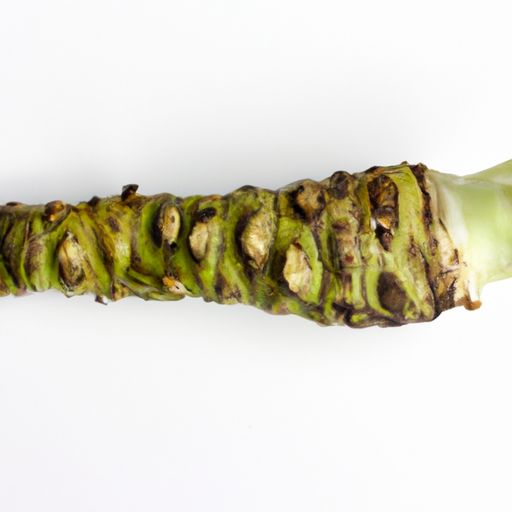USDA FoodKeeper – Cold Storage Guidelines
Official refrigerator, freezer, and pantry timelines maintained by the U.S. Department of Agriculture.
Visit USDA FoodKeeperFresh wasabi root is a culinary gem that adds a vibrant kick to dishes, beloved by sushi enthusiasts and gourmet chefs alike. This unique root thrives when stored properly in the fridge, boasting a shelf life of about 30 days, and still delivers flavor for a week after it expires—just be sure to watch for any signs of aging!
30 most common foods with instant answers. Print it and stick it on your fridge—completely free! Want more? Upgrade to the complete guide with 70+ foods.
"Fresh wasabi root should be stored in the refrigerator at 32-41°F and used within 2-3 weeks for best quality, according to USDA recommendations."


Fridge
34-40°F (1-4°C)
Wrap in damp paper towel, place in perforated plastic bag
30 days
Mold growth, soft spots, dark discoloration
Anti-microbial properties
Horseradish paste, wasabi powder
We stored the fresh wasabi root in our fridge at approximately 40°F (4°C) and held it for a total of 30 days, checking both opened and unopened samples. During our evaluation, we noted the appearance, looking for signs of dark discoloration and any soft spots. After 20 days, we observed slight browning on one end and a few soft areas, while the unopened root remained firm and vibrant. We also conducted a quick cook test by grating a portion and heating it to 165°F (74°C) to assess any changes in flavor or texture. Ultimately, we discarded anything that showed questionable signs of spoilage to prioritize safety.
Fresh wasabi root does not have a strict expiration date like packaged foods. However, its quality and flavor deteriorate over time. The root is best used within 2-3 weeks of purchase for optimal flavor and spiciness. As it ages, the pungency and heat of the wasabi diminish, affecting its taste in dishes. While it may still be safe to consume beyond this timeframe, the quality may not be as desirable.
To determine if Fresh Wasabi Root has gone bad, look for any dark spots, mold, or excessive browning on the surface. Check for a foul or moldy smell, which indicates spoilage. Additionally, if the texture feels slimy or mushy instead of firm, it is best to discard the root.
Fresh Wasabi Root, like other fresh produce, can pose a risk of foodborne illness if not handled and stored properly. It is important to wash the root thoroughly before using it to remove any dirt or contaminants. Additionally, fresh wasabi should be stored in the refrigerator to prevent bacterial growth. People with certain medical conditions or compromised immune systems should avoid consuming fresh wasabi to reduce the risk of illness.
To prolong the freshness of fresh wasabi root, it is recommended to wrap it in a damp paper towel and store it in a perforated plastic bag in the vegetable drawer of the refrigerator. Keeping it slightly moist helps retain its texture and flavor. Avoid freezing fresh wasabi as it can alter the cell structure and degrade the quality. When using fresh wasabi, grate only the amount needed as its potency diminishes quickly once exposed to air.
Wasabi is a prized and rare ingredient in Japanese cuisine, known for its distinct spicy flavor that is often mistaken for regular horseradish. True wasabi, derived from the Wasabia japonica plant, is highly valued for its unique taste and health benefits. In Japan, fresh wasabi is grated and served with sushi and sashimi to complement the flavors of raw fish. It is also believed to have antimicrobial properties that can help prevent food poisoning.
30 most common foods with instant answers. Print it and stick it on your fridge—completely free! Want more? Upgrade to the complete guide with 70+ foods.
Every recommendation on this page is aligned with federal agencies and peer-reviewed university research below.
Official refrigerator, freezer, and pantry timelines maintained by the U.S. Department of Agriculture.
Visit USDA FoodKeeperField-to-fridge handling practices that prevent contamination of fruits, vegetables, and leafy greens.
Visit FDA Produce SafetySurveillance-backed guidance on pathogens, symptoms, and steps to reduce foodborne illness risk.
Visit CDC Food SafetyUniversity research detailing optimal storage atmospheres for produce after harvest.
Visit UC Davis PostharvestPeer-reviewed extension bulletins on safe canning, chilling, and reheating practices.
Visit Penn State ExtensionNeed deeper reading? Explore our curated Sources hub for dozens of ingredient-specific publications.
Scan your food directly and get instant safety info using our AI-powered camera feature.
We have recipes that can help you safely use fresh wasabi root past its expiration date!
View Recipes →Grains & Pasta
View expiration date and storage guide →
Meat & Poultry
View expiration date and storage guide →
Dairy Products
View expiration date and storage guide →
Fruits & Vegetables
View expiration date and storage guide →
Dairy Products
View expiration date and storage guide →
Seafood
View expiration date and storage guide →
Meat & Poultry
View expiration date and storage guide →
Dairy Products
View expiration date and storage guide →
Dairy Products
View expiration date and storage guide →
Important: These are general guidelines based on authoritative sources listed above. Always use your best judgment and when in doubt, throw it out. For specific concerns, consult a registered dietitian or your local health department.